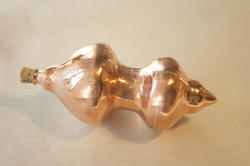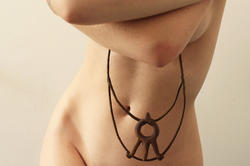RISD’s Jewelry + Metalsmithing department honors the legacy of late faculty member Michael Glancy in its ongoing Triennial.
Symbols of Resistance

This Wintersession students from the Apparel Design and Jewelry + Metalsmithing departments came together for Pièce de Résistance, a new studio taught by recently hired Associate Professor JOFF. Working together in small cross-disciplinary teams, students wrote manifestos, created hybridized pieces between garments and jewelry and came up with supporting promotional campaigns related to the act of protest.
“Protestors have always used their bodies to convey their ideologies—marching in large groups, chaining themselves to trees and organizing sit-ins, for example.”
“Protest is an extremely important tool for self-expression, change and innovation,” JOFF explains. “Central to the act of protest are ideologies, the things we believe in and the things we would like to change. Protestors have always used their bodies to convey their ideologies—marching in large groups, chaining themselves to trees and organizing sit-ins, for example. But we also wear badges and t-shirts and carry banners and flags expressing our convictions.”

In late January Eve Adami 23 AP, Monserrat Fernandez-Moreno 22 AP, Cecilia Habgood 23 AP and Jingtong Zhang 24 JM brainstormed ideas to express their concerns about the dangers of violence in pornography, which can perpetuate violence in the real world, especially towards women. They discussed creating a two-piece look intended to subvert societal norms by emphasizing the wearer’s nipples and testicles, body parts they see as oversexualized.
“I’ll cut the plates out of a sheet of copper and then hammer them into the shape of breasts.”
The pants they envisioned would be denim, a fabric that JOFF notes is associated with masculinity due to its roots in workwear, while the top would be a cross between a garment and an accessory created by connecting multiple nipple-shaped plates made out of copper and leather. “I’ll cut the plates out of a sheet of copper and then hammer them into the shape of breasts,” Zhang explained during their planning session.

At another bench junior Zoey Li 23 AP worked alone on a utility vest whose stuffing would be dyed in pretty pastel colors, embellished with plastic yarn and attached to the garment’s exterior. “I’m calling the piece Curated Vulnerability,” Li explained, “and the idea is that it’s OK—even empowering—to express your vulnerability.”

As the class wrapped up, Jewelry + Metalsmithing faculty members Tracy Steepy and Timothy Veske-McMahon prepared to review the work in final crits. “We’ve been trying to put together a cross-disciplinary course with the Apparel Design department for a while now and are delighted that JOFF was able to make it happen,” Steepy noted.
Partners Valerie Ho MFA 23 JM and Luke Teigen 24 AP opened the session with an illuminating presentation about protesters’ use of umbrellas in Hong Kong and the significance of tents here in the US to draw attention to homelessness. “Hong Kong protestors use umbrellas to hide their identities from the government and also as protection from pepper spray, tear gas and rubber bullets,” Ho explained.


Their project combines both symbols of resistance, voicing the overarching message that “the system is failing.” They used metal tubing reminiscent of an umbrella’s underside to form a honeycomb structure over which they draped a variety of cut-up secondhand garments referencing makeshift tent structures.
“It would have been interesting to see what the piece would look like if you used plastic tarps like the ones you see in tent cities,” Steepy noted. And JOFF wondered if the piece would more clearly highlight the shared societal problem of homelessness if it was presented in the ad campaign on more than one model.


Sophomore Gene Suh 24 AP (see top photo) modeled the piece shown next, created by a team that included Nayderson Fallon 23 AP, Fei Gao MFA 23 JM, Sarah Park 23 AP and Yue Zi 23 AP. Held together precariously with copper safety pins, the garment speaks to the trauma of immigration and starting over in a new country without much more than the clothes on one’s back.
“We focused on the prejudice against immigrants, especially since COVID,” Zi explained. “This piece features distressed fabric and raw edges and represents the idea of mending—reconnecting shattered pieces.”
“This piece features distressed fabric and raw edges and represents the idea of mending—reconnecting shattered pieces.”
“The use of the safety pin is brilliant,” noted Steepy. “Whoever you’ve been and whoever you want to be can be modified. It isn’t fixed.”
The team also reimagined the US green card as a badge of honor drawing attention to each immigrant’s unique story, and passed out screen-printed cotton samples visitors could pin to their clothing.

JOFF was taken by the project and described it as “strong collaborative work. The students in this first iteration of the course brought important and relevant topics to the table and were able to utilize their expertise and skill in creating work with real intention,” he adds. “They shared their experiences, perspectives and concerns about the world we live in and through this dialogue found common ground and developed meaningful propositions for change.”
—Simone Solondz / photos by Jo Sittenfeld MFA 08 PH
February 21, 2022


